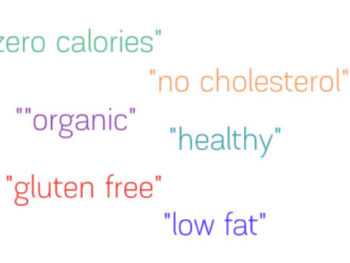Below is my blog post for Huffington Post, Will new food labels encourage us to eat…more?!
You can also read it HERE.
In February 2014, the Food and Drug Administration (FDA) along with Michelle Obama announced an overhaul to the nutrition facts label required on all packaged foods. Among the proposed changes includes updating the serving sizes.
As FDA states, “These updates would reflect the reality of what people actually eat, according to recent food consumption data. By law, serving sizes must be based on what people actually eat, not on what they ‘should’ be eating.”
The food labels have not been revised in over 20 years, and the current serving sizes are based on portions typically consumed in the 1970s and 1980s.
We eat larger portions than we did 20 years ago, so current serving sizes are smaller–often much smaller–than what people actually eat. As I’ve written in my book The Portion Teller Plan and research articles, these serving sizes may be confusing to people trying to follow dietary advice.
In a previous piece I wrote for Huffington Post, while I commended the FDA for using more realistic serving sizes, I also offered a note of caution: in particular, that FDA is not telling consumers to actually eat more.
“For the good news, as I discussed on CBS Morning News, the serving sizes will be more realistic and reflect what people really eat. Many people today just glance at the calories and think that whatever amount they eat is a serving. For the ice cream example, a consumer reading food labels will now see 400 calories displayed instead of 200 calories. This may mean that you would think twice before scarfing down the entire pint.
A note of caution: FDA is not telling us to eat more. At least, the agency is not advising us to eat a bigger portion of ice cream. Rather, the agency is informing us as to the calorie and nutrient content in a standard serving size which is more in line with what we really do eat…. It would be useful if FDA follow up with nutrition education materials to further educate the public on the relationship between portion sizes, calories, and obesity.”
While there are clearly benefits to FDA requiring that manufacturers use more realistic serving sizes, a new study, published in the journal Appetite, addresses some potential problems with larger serving sizes. The study explores how consumers interpret the new serving sizes, and how they affect the amount of food they would serve themselves.
In one of several experiments, the researchers showed subjects two different labels for mini chocolate chip cookies–the current label which states 3 cookies as a serving and the proposed new label which lists 6 cookies as a serving. The subjects exposed to the proposed label served themselves significantly more cookies than those exposed to the current label.
Results of all four experiments found that people misinterpret serving size information. The majority of subjects believe that the serving size on a food label refers to how much they should eat. The researchers also found that the increased serving sizes on the proposed Nutrition Facts label can lead people eat more and purchase more food.
Uh oh! This is troubling, especially in a society where many of us already eat too much.
The researchers write, “We found that people misinterpret serving size information, with the vast majority of consumers incorrectly believing that the serving size refers to how much can/should be consumed.”
Lead author Steven Dallas, a doctoral candidate at New York University’s Stern School of Business wrote me the following in an email message: “Our research shows that the increased serving sizes of the proposed label lead consumers to serve more food for themselves and others. Since excessive consumption is a key contributor to obesity, this is a worrisome effect of the proposed label.”
Results of this study confirm that consumers may incorrectly view serving sizes as recommendations. Hopefully, FDA will take these findings into account when finalizing its serving-size rulings for the new food labels.
The authors conclude in their paper, “FDA should be encouraged to consider ways to correct this misinterpretation, such as by mandating the addition of a serving size definition to the proposed Nutrition Facts label. The definition could inform consumers that the serving size refers to how much of the product a typical person consumes in one sitting, and does not refer to how much of the product can be healthily consumed in one sitting.”
I agree!
In my comments last year to FDA on the proposed serving-size change, I suggest that FDA should pro-actively address concerns about the possible unintended consequence that some consumers view serving sizes as portion recommendations. I wrote, ” I recognize that the RACCs used to calculate serving sizes are required to be based on the amount of food people customarily consume, and are not recommended amounts of food to eat. However, given the likelihood of confusion among some consumers, I strongly recommend that the FDA include clarifying language on the label by either: 1) denoting the serving size provided as a “typical” serving size or 2) including a footnote to clarify that “the serving size is based upon the amount typically consumed, and is not a recommended portion size.”
Stay tuned.
In the meantime, we would love to hear your thoughts and recommendations on the new proposed serving sizes.




